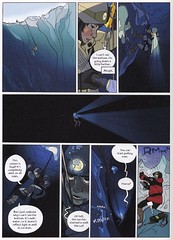Global Storytelling
Risto Isomäki is a Finnish science journalist, environmental activist, and science fiction writer. He’s published several novels and short stories and been nominated for the Finlandia award (the biggest and most prestigious Finnish literary award) for his sf ecothriller Sarasvatin hiekkaa.

The story is set in the 2020s. A Russian scientist is invited to India because he’s invented a special submarine that might be suitable for researching the odd discoveries made near the Indian coast. There are traces there of ancient civilizations previously unknown to scientists, and as big a mystery as their discovery seems to be the way they’ve suddenly been destroyed. Meanwhile a Finnish eco-activist is developing potential means for stopping the polar ice caps from melting. And in Greenland, local research team makes some very strange and disturbing discoveries.
The story deals with the effects of global climate change, a subject Isomäki has been interested in since the early 1980s, and still is—his latest book is a non-fiction book called 34 tapaa estää maapallon ylikuumeneminen (“34 ways to stop the Earth from over-heating”). The Sands of Sarasvati speculates on possible consequences sudden changes in the climate might have for our planet and their fascinating similarities with some hypothetical ancient civilizations (as imagined from both old myths and current real-world research).
Isomäki is in many aspects—good and bad—a typical hard sf writer. His books tend to have a big (actually, huge) idea, around which the story centers. He backs up his speculation with an impressive amount of facts (unfortunately many of those make it to the pages of the books as serious infodumping). The world and the speculation—and often the message he’s conveying—are the main point of the books, and while they create real sense of wonder, at the same time his plot is often very straightforward, and the characters are there to serve the story and are often left rather thin. Isomäki is clearly at his best when he’s describing his big ideas, but his dialogue can be awkward, especially when describing the relationships between his characters.

Isomäki’s story doesn’t shy away from making changes in his world, and there are no easy cures for big problems here. This definitely isn’t a story where a brave action hero single-handedly saves the world, and sometimes you can come across a problem that’s impossible to solve or a disaster that just can’t be prevented. There is, however, a message of hope in Isomäki’s writing. Even though the current situation may be grim, he thinks that mankind can survive with cooperation, scientific research, and also the aid of technology (here he refreshingly sets himself apart from so many eco-activists who distrust all technology—even when using the Internet to spread their word—and are endlessly cynical and pessimistic about the nature of the human race).

You can see the images in this post in higher resolution in a blog post by the translator of the English edition.
The Sands of Sarasvati is published by Tammi Kustannusosakeyhtiö. ISBN: 9789513144906.
6 comments on “Global Storytelling”
Tero, I’ve just started reading a copy I was kindly sent over and finding it to be quite a gripping bit of near-future SF with a contemporary eco message – would appeal to those of us who like Kim Stanley Robinson’s work, I think. And refreshing to see some hard SF in comics form – despite a bit of crossover between SF&F and comics readers the comics medium often tends to more fantastical SF. This feels and looks more like proper SF, with a look like a French adult BD book, really enjoying it.
I wouldn”t recommend this case. Cheaply assembled. Now the case is used for my 2nd iPad (mainly at- home uses), 1st iPad case”s Incipio Destroyer. BTW, Destroyer is really HEAVY!, it doubles the weight of iPad (kinda heavy to hold with one hand even for guys like me) But, I feel like it”s solid and strong enough to protect.The app downloaded for me from the iTunes store. App is called Google Books. Interesting thing, it seems to link it with your Google e-mail account. The scary thing there is the lack of support/recourse if your account gets hacked or killed by Google. The more linked to your account, the more you are screwed if it is lost.I have an iPad and my wife has a g2 Kindle. The iPad works great for quick reading…the Kindle is light years better for serious reading. I say that due to the weight and e-ink being much easier on my eyes. Like jeffo said, with the Kindle app available, and in my opinion superior to iBooks, I don”t think Amazon is worried.
Comments are closed.